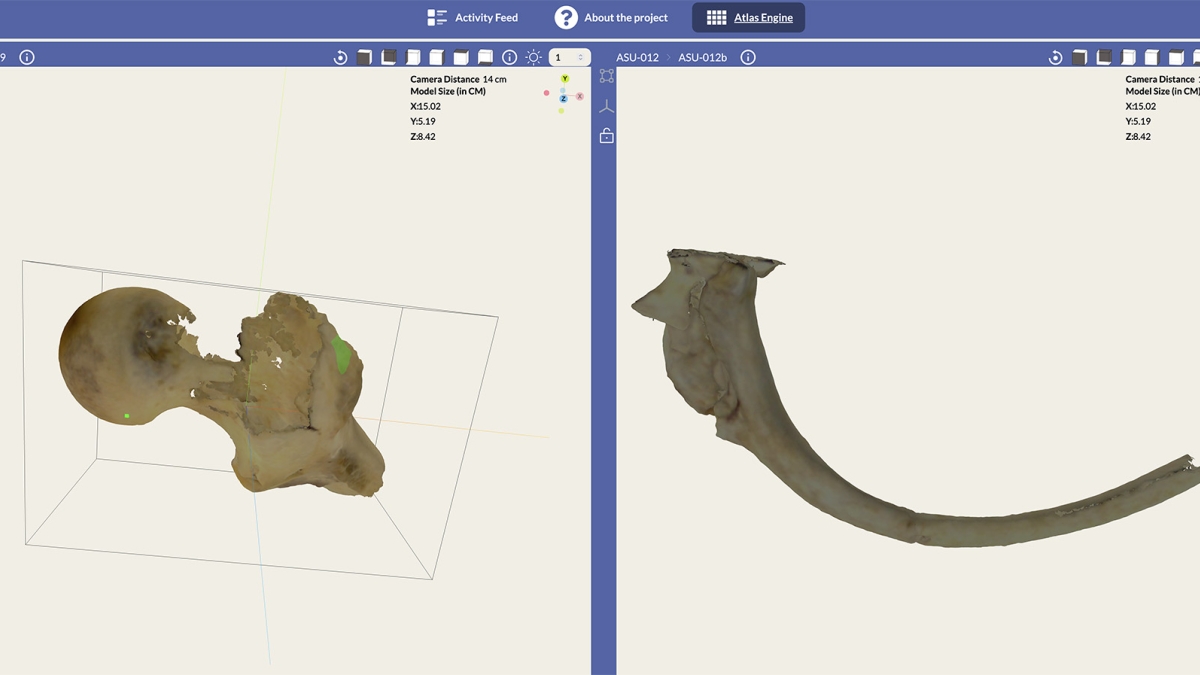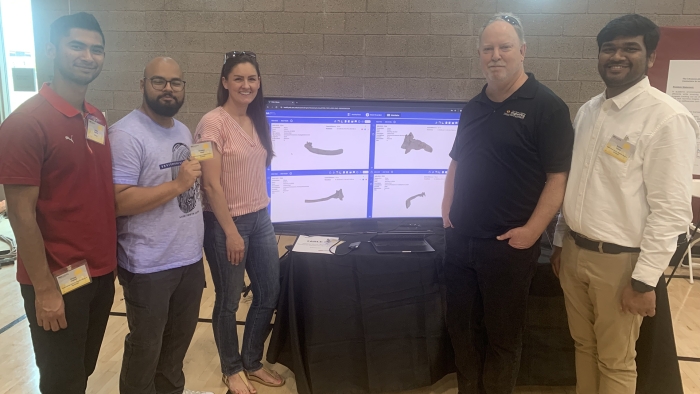ASU team creates 3D bone atlas to stop elder abuse

Software developed by ASU professors Kevin Gary and Katelyn Bolhofner provides tools that will allow professionals to compare bone scans, use digital tools to take measurements and collect data. Photo courtesy of Kevin Gary
“Only our bodies know the truth. Bones don’t lie,” writes Tayari Jones in “An American Marriage.”
No one understands the power of this statement quite like Katelyn Bolhofner.
The assistant professor of forensic anthropology in the School of Interdisciplinary Forensics at Arizona State University is a board-certified forensic anthropologist. As an expert in skeletal biology, she has put her prowess to work conducting active casework and advising medical examiner offices on extracting usable information from degraded and burned bones. Her projects have received funding from the National Science Foundation and the Wenner-Gren Foundation.
Now, Bolhofner has teamed up with Kevin Gary, an associate professor of software engineering in the School of Computing and Augmented Intelligence, part of the Ira A. Fulton Schools of Engineering at ASU, to create a 3D skeletal bone atlas.
The pair of researchers aim to tackle a difficult, growing problem: elder abuse.
One critical challenge when dealing with elder abuse is that it can be difficult for criminologists, pathologists and others to tell the difference between accidental injuries and those that are the result of intentional harm or neglect. So with a grant from the National Institute of Justice, Gary and Bolhofner have combined their expertise to create digital tools to diagnose bone fractures.
Their software solution will allow law enforcement to better investigate elder abuse cases and help caregivers and medical responders understand when intervention is needed.
Related story
Read more about Bolhofner's initial work on this project.
Agile engineering for adaptable solutions
Gary is an associate professor and software engineer who has a background in creating computer applications for health care. He also teaches classes in the School of Computing and Augmented Intelligence such as SER 516: Software Agility and SER 421: Web-Based Applications. He saw Bolhofner’s project as an ideal learning opportunity for his students.
Gary worked with a small group of master’s degree students to create a software system to deliver Bolhofner’s ideas. Their web-based application allows users to view and compare 3D bone scans, assemble an online notebook, use digital tools to take measurements and collect data, and — most crucially — to share what they have learned with other professionals.
Gary says expert engagement is an essential part of the project.
“In many cases, we’re replacing resources that are quite dated. Some of this kind of work is still being done with a paper and a pen,” he says. “Our plan is to put the skeletal bone atlas out as a resource for the forensic science community to use.”
He also believes that the project was a useful way for his students to see the concepts of agile software engineering in action, applied in real-world settings. Agile software engineering is a development style where engineers work in small teams focused on the delivery of individual parts of a piece of software.
The team demonstrated the system at the Spring 2024 Innovation Showcase held on ASU’s Polytechnic campus, which is also the home of the school’s software engineering program.
Gary believes that the experience was highly beneficial and prepared the students for their future work.
“When student teams write software in my lab, I lead them the same way that I would on industry projects,” Gary says. “The students were able to see many of the things that they learned in the classroom, such as how to deal with design requirements and come up with an engineering solution, put into practice.”
Artificial intelligence can help human experts
Through their work, Gary and Bolhofner speculated that artificial intelligence might offer enhanced options for experts. They asked themselves if AI could be used to help Adult Protective Services identify abuse cases that otherwise might have been missed. They considered how AI would reduce bias in forensic experts as they were called to testify in criminal proceedings.
Gary is spearheading the development of a machine learning system, a type of AI where his software will take in bone scans and other data from the application. This will be combined with probability information, allowing the atlas to identify patterns. The information can then be flagged for the expert user. The system might alert a user that a certain type of fracture is unlikely to be accidental and prompt the expert to take action, such as removing an older adult from a dangerous environment.
Next, the researchers will get feedback from potential professional users. In February 2025, Gary and Bolhofner will lead a usability workshop at a conference held by the American Academy of Forensic Science. Gaining user acceptance in this specialized field requires user-centered design engineering, and the team hopes to get valuable insight from anthropologists, law enforcement specialists and academy members.
While elder abuse is a serious, tough topic, Bolhofner is motivated by a desire to protect a vulnerable population.
“There are criminal justice applications for the work, as it may ensure the most just outcome for someone who’s been a victim of abuse,” Bolhofner says. “But there’s also a sense of hope that the project will allow older adults to get help before it’s too late.”
More Science and technology

ASU-led space telescope is ready to fly
The Star Planet Activity Research CubeSat, or SPARCS, a small space telescope that will monitor the flares and sunspot activity of low-mass stars, has now passed its pre-shipment review by NASA.…

ASU at the heart of the state's revitalized microelectronics industry
A stronger local economy, more reliable technology, and a future where our computers and devices do the impossible: that’s the transformation ASU is driving through its microelectronics research…

Breakthrough copper alloy achieves unprecedented high-temperature performance
A team of researchers from Arizona State University, the U.S. Army Research Laboratory, Lehigh University and Louisiana State University has developed a groundbreaking high-temperature copper alloy…


